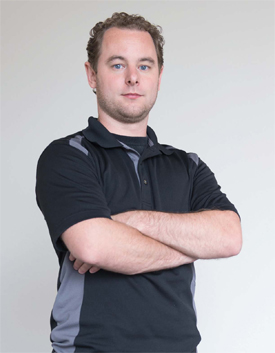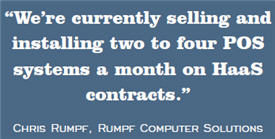Give Your Company A Managed Service Makeover
By The Business Solutions Network
After three years of razor-thin profit margins, this POS VAR-turned-MSP’s new focus on selling HaaS (Hardware-as-a-Service) and payment processing services is leading to a second year of triple-digit revenue growth.

Many VARs’ success stories share a similar formula that could be summarized: “We were good before and now we’re even better. Here’s why.” Rumpf Computer Solutions’ success story does not fit this description. In 2006, while still a junior attending the University of Toledo, Chris Rumpf launched Rumpf Computer Solutions after getting laid off from an IT administrator position. After two years of operating solo, Rumpf started growing his business and began hiring salespeople and technicians. “I didn’t have any management skills, and within a year the business was pretty far in the red,” he recalls. It was at this point that Rumpf had one of those life-changing moments where he looked at his options, which included shutting down the business and working for someone else or figuring out a way to make his business work. With the thought of working in a cubicle every day and earning a nominal living as his motivation, Rumpf focused on the changes he needed to make to turn things around. Not only is his success story inspiring on multiple levels, but also it’s a much-needed message that the vast majority of hospitality VARs need to hear
Conduct A Business Failure Analysis
One of the first difficult decisions Rumpf had to make in 2009 was to let go all of his employees. He then hired Director of Marketing Alex Hughes, who he knew would play a key part in rebuilding the business. “After looking at our current situation, we recognized two contributing causes to our predicament,” says Rumpf. “First, we had no vertical market focus. We were prospecting and accepting business anywhere we could get it, and we just weren’t able to develop expertise in any one area. Also, 95 percent of our business entailed offering break-fix professional services support.” Rumpf adds that not only did relying on break-fix services make his cash flow unpredictable, but also his pricing model made it unprofitable, too. “Instead of automating business processes to reduce costs for ourselves and our customers, we just kept raising our prices because we never seemed to make enough margin to be successful,” he says.
After identifying the two changes they wanted to make to the company, Rumpf and Hughes focused on some of the good things about the business they wanted to build upon. “After consulting with several business colleagues outside the IT channel, we decided hospitality was the best market for us to focus our attention,” says Rumpf. “Not only did we like this market and selling point of sale [POS] solutions the best, but we saw this vertical as offering the best opportunity to earn recurring revenue.”
Don’t Settle For Payment Processing Referral Commissions
After receiving a small commission check from a payment processor, the light went on in Rumpf’s head that this was a major opportunity for recurring revenue he had been overlooking. “We were doing what a lot of retail VARs do, which is simply referring new hospitality customers to payment processors and receiving a meager commission in return. The reality is that when restaurants aren’t able to complete credit card transactions, they don’t call the processors, they call their VARs, so why shouldn’t VARs earn better margins from payment processing fees?”
Rumpf spent the next several months learning about payment processing and struck relationships with two large payment organizations. By partnering with larger players, Rumpf was then able to negotiate his own payment rates with customers, plus he was able to earn a commission rate several times higher than what he was earning previously. “Not only are the rates better, but also each payment contract I enter with a customer becomes an asset that I own, which has a value that banks and other organizations take into consideration when qualifying businesses for loans or lines of credit. Assets also play a part in the overall value of a business if we ever wanted to sell the practice.”
Rumpf says that partnering with a larger player and paying closer attention to the payment card processing industry has opened his eyes to a whole other side of the industry he serves. “Merchant processing is full of shady characters that are gouging retailers,” he says. Now that Rumpf Computer Solutions has control of that aspect of the business, it can play an active role in challenging this problem. “We have one customer who runs an ice cream shop that does more than $1 million in credit card sales just in July and August alone,” he says. “After we reviewed their payment agreement, we were able to set them up with a new agreement that saved them $25,000 compared with their previous agreement and was still financially worth our while, too.”
Earn Recurring Revenue Selling HaaS
One other area where Rumpf has seen a dramatic turnaround with its business is — believe it or not — selling POS hardware. On his own, without any help from distributor partners or a master MSP, Rumpf developed a HaaS program for selling POS systems. “We buy the POS equipment [which typically includes J2 Retail Systems touch screens and terminals] outright and finance it in-house. Just like with payment processing, we don’t share profits with any middlemen if we don’t have to.” Rumpf does admit that as a small business owner who very much still remembers the financial years in the red, financing his HaaS-based POS does require a few self-imposed restrictions, including a lot of patience. Sixteen months’ worth of patience to be exact. “It takes nearly a year and a half to start making a profit off of a HaaS POS sale,” says Rumpf. “If you amortize that monthly payment over a three-year period, however, it becomes 30% more profitable than selling a POS system outright. And, when you consider the fact that the average POS system runs six years or more, the profitability becomes exponentially higher with the HaaS model than the traditional sales model.”
 To avoid having too many customers in the 16-month unprofitable period, Rumpf applies the 80/20 rule to his HaaS sales. “Eighty percent of deals requiring three or fewer POS terminals are sold as HaaS, but only 20 percent of deals with more than three lanes are sold as HaaS,” he says. Things actually work out this way naturally with very little “steering” required. “Larger customers prefer to own the equipment themselves, so we don’t need to worry about too many of them asking about our HaaS program,” he says.
To avoid having too many customers in the 16-month unprofitable period, Rumpf applies the 80/20 rule to his HaaS sales. “Eighty percent of deals requiring three or fewer POS terminals are sold as HaaS, but only 20 percent of deals with more than three lanes are sold as HaaS,” he says. Things actually work out this way naturally with very little “steering” required. “Larger customers prefer to own the equipment themselves, so we don’t need to worry about too many of them asking about our HaaS program,” he says.
One other rule Rumpf follows strictly, which applies to customers of all sizes, is that he doesn’t sell HaaS systems to customers with bad credit. “If we decide to do business with a restaurant that has bad credit, we’ll recommend them to a leasing company, where the burden of paying for the equipment is between the leasing company and the customer only.”
Today, nearly half of all Rumpf Computer Solution’s sales come from selling HaaS, and as the company has more and more customers reaching the 16-month breakeven point in their HaaS contracts, it’s able to use a portion of its profits to sell more HaaS contracts. “We’re currently selling and installing two to four POS systems a month on HaaS contracts,” he says. “By year’s end we expect that number to be even higher.”
Automate Your Managed Services
Since its inception, Rumpf Computer Solutions has used LabTech’s RMM (remote monitoring and management) tool, and it sold proactive maintenance services to its customers. But, during its first three years, it made a few mistakes that made its managed services unprofitable. “We only charged customers $10 a month, and the only service we offered was managing hard drives and pushing out Windows updates,” says Rumpf. “Plus, we weren’t using a PSA [professional services automation] tool to automate and remediate problems identified by our RMM program.”
One of the changes it made to its managed services offering was to expand its RMM usage to include servers. “We also started using automation features such as remote auto restart,” he says. “That way if a server crashes, causing all the terminals at the restaurant to stop working, an agent running in the LabTech cloud data center automatically reboots the server, which shortens the customer’s downtime significantly. We’re also now offering our hospitality customers secure cloud backup as well as Antivirus-as-a-Service.”
Adding automation functionality and additional monitoring services enables Rumpf Computer Solutions to charge five times more than it used to charge previously, which not only helps drive its profitability per customer, but also helps offset its initial HaaS expenses. “Over the past year alone, our monthly recurring revenue from payment processing commissions, HaaS, and remote monitoring services has tripled,” says Rumpf. “Right now, 90 percent of our operating expenses are covered by recurring revenue, and within the next five years, 200 percent of our operating expenses should be covered by recurring revenue services.”
Within the past year, the MSP’s LabTech contacts introduced it to PSA vendor ConnectWise (See sidebar on page 22 for more info on this partnership). “Having a PSA that’s integrated with our RMM is already helping us provide better service to our customers and automate several business processes,” says Rumpf. “Even though the past couple of years have been spent working hard at investing in the business and getting our finances back on track, our efforts are finally paying off. Besides the positive responses we’ve received from our customers and the significant increases in our revenue and profit margins, we’ve been able to unseat a few competitors who’ve been incumbents for as many as 30 years. What’s more is that we’ve discovered that customers who are on a managed services plan with us are four times more likely to refer us to another company than break-fix only customers — which is another confirmation that managed services is good for us, and it’s a good thing for them.”

